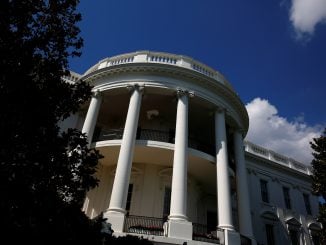
Twitter escalated tensions with President Donald Trump on Friday, adding a warning to one of his tweets for the first time and saying he violated the platform’s rules by glorifying violence when he suggested protesters in Minneapolis could be shot.
Trump has been railing against the company since earlier this week, when it for the first time applied fact checks to two of his tweets. Those were about mail-in ballots.
The flap comes at a fraught moment for Twitter and social media more generally. Debate is heating up about when and how much these companies should police the content on their platforms as coronavirus misinformation swirls and the 2020 U.S. presidential election looms.
For Trump, the feud with Twitter serves as a convenient distraction from major challenges he faces heading into November, such as controlling a pandemic and dealing with soaring unemployment.
The Trump tweet that was flagged Friday came amid days of violent protests over the death of George Floyd, a handcuffed black man who pleaded for air as a white police officer kneeled on his neck.
“These THUGS are dishonoring the memory of George Floyd, and I won’t let that happen,” Trump tweeted about the protesters. “Just spoke to Governor Tim Walz and told him that the Military is with him all the way. Any difficulty and we will assume control but, when the looting starts, the shooting starts. Thank you!”
Twitter did not remove the tweet, saying it had determined it might be in the public interest to have it remain accessible. But the tweet was hidden so that a user looking at Trump’s timeline would have to click on the warning to see the original tweet. Hiding it also effectively demotes the tweet by limiting how users can retweet it and ensuring that Twitter algorithms don’t recommend it.
Twitter said Friday it posted the warning labels on Trump’s tweets “based on the historical context of the last line, its connection to violence, and the risk it could inspire similar actions today,” but left them up “given its relevance to ongoing matters of public importance.”
A tweet using the same language as Trump’s was later posted on the official White House Twitter account, and Twitter eventually put a warning on that too. It was also posted on Facebook, which hasn’t taken any visible action on it.
Trump took to Twitter to complain, calling multiple times for the revocation of Section 230, part of a 1996 law overhauling telecommunications. That section generally protects social media platforms from liability for material users post on their platforms. Trump on Thursday signed an executive order challenging those protections.
The order directs executive branch agencies to ask independent rule-making agencies including the Federal Communications Commission and the Federal Trade Commission to study whether they can place new regulations on the companies, though experts express doubts much can be done without an act of Congress.
The president and fellow conservatives have claimed for years that Silicon Valley tech companies are biased against them.
Twitter first outlined in early 2018 that it wouldn’t block world leaders from the platform or remove their controversial tweets. But it announced nearly a year ago that it could apply warning labels and obscure the tweets of world leaders if they used their accounts to threaten or abuse others. That followed complaints from Trump critics that the president has gotten a free pass from Twitter to post hateful messages and attack his enemies in ways they say could lead to violence.
Twitter further clarified its rules in October, saying it will enforce its policies against any user who makes clear and direct threats of violence against a person, but carving out an exception for government officials’ “foreign policy saber-rattling on economic or military issues.”
The earlier tweets that Twitter flagged were not hidden but did come with an option to “get the facts about mail-in ballots,” a link that led to fact checks and news stories by media organizations. Those tweets called mail-in ballots “fraudulent” and predicted that “mail boxes will be robbed,” among other things.
Twitter’s decision also likely will be seized upon outside the U.S. to scrutinize the social media behavior of other world leaders. Israel has been waging its own pressure campaign on the company over it allowing Iranian Supreme Leader Ayatollah Ali Khamenei to have an account.
In a letter dated Sunday, an Israeli official wrote to Twitter CEO Jack Dorsey complaining about Khamenei tweets that repeated comments he made in a recent speech in support of Palestinians that called Israel a “cancerous growth” that will be “uprooted and destroyed.”


